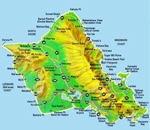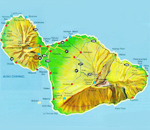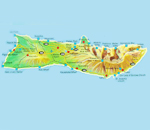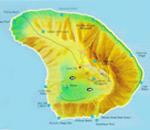 |
| Aloha Magazine - History, Hawaii |
| The earliest settlements in the Hawaiian Islands were created by Polynesians who arrived in Hawaii using large double-hulled canoes. They brought with them pigs, dogs, chickens, taro, sweet potatoes, coconut, banana, and sugarcane. There are several theories regarding migration to Hawaii. The "one-migration" theory suggests a single settlement. A variation of the one-migration theory instead suggests a single, continuous settlement period. A "multiple migration" theory, supported by some early scholars, suggests that there was a first settlement of Hawaii by the Menehune (settlers from the Marquesas Islands), and then a second settlement by the Tahitians. Under this multiple migration theory, the later migration of taller and physically stronger people from Tahiti displaced (or otherwise overthrew) the earlier Menehune people, who fled to the mountains. Evidence of this earlier migration by the Menehune exists in various forms around the islands, such as the Menehune Fish Pond on Kaua'i. Proponents of this theory also point to an 1820 census of Kaua'i by Kaumuali'i, the then-ruling chief of the island, which listed 65 people as "Menehune" (Schmitt, 1981). On January 18, 1778, Captain James Cook and his crew, while attempting to discover the Northwest Passage between Alaska and Asia, were surprised to find the Hawaiian islands so far north in the Pacific.[1] He named them the "Sandwich Islands". After the discovery by Cook, other Europeans and Americans came to the Sandwich Islands. An entry was found in James Cook's log describing the natives as "riding the ocean's waves on wooden boards", which became the first written account of surfing. Hawaii was united under a single ruler, Kamehameha I, for the first time in 1810 with the help of foreign weapons. Until 1816, the chiefs of the various islands considered themselves under British protection and flew the Union Flag. The monarchy then adopted a flag similar to the one used today by the State of Hawaii. It had the present flag, with the Union Flag in the canton (top quarter next to the flagpole) and eight horizontal stripes (alternating white, red ,blue, pink, and purple from the top), representing the eight major islands of Hawaii. In May 1819, Kamehameha II (Liholiho) ascended the throne. Under intense pressure from his co-regent and stepmother, Ka'ahumanu, he abolished the kapu system that had ruled life in the islands. He signaled this revolutionary change by sitting down to eat with Ka'ahumanu and other women of chiefly rank. This action violated kapu by eating with a woman, an act forbidden under the old religious system—see 'Ai Noa. Kekuaokalani, a cousin who was originally designated to share power with Liholiho by Kamehameha, organized dissidents in favor of preserving the kapu system. His forces were defeated by Ka'ahumanu and Liholiho in December 1819. In March 1897, William McKinley succeeded Grover Cleveland as president. He agreed to a treaty of annexation, but it failed in the Senate with the submission of the Ku’e petitions. A joint resolution was written by Congressman Francis G. Newlands to annex Hawaii. McKinley signed the Newlands Resolution which provided for the official annexation of Hawai'i on July 7, 1898. The islands officially became Hawai'i Territory, a United States territory, on February 22, 1900. The territorial legislature convened for the first time on February 20, 1901. The overthrow of the Kingdom of Hawai'i and the subsequent annexation of Hawai'i has recently been cited as the first major instance of American imperialism. In 1993, the US Congress passed Public Law 103-150 ("The Apology Bill") which corrects misinformation regarding the overthrow of the monarchy and apologizes on behalf of the United States for the "suppression of the inherent sovereignty of the Native Hawaiian people. President Dwight D. Eisenhower signed a bill on March 18, 1959 which allowed for Hawaiian statehood. Hawaiʻi formally became the 50th state of the Union on August 21, 1959 after a vote of over 94% in favor of statehood. |
 |
The old Kingdom of O'ahu was once ruled by the most ancient Ali'i in all of the Hawaiian Islands. The first great king of O'ahu was Mailikukahi, the law maker, who was followed by many generation of monarchs. Surfing was the sport of kings. |
Hawaiʻi is said to have been named for Hawai'iloa, the legendary Polynesian navigator who first discovered it. Other accounts attribute the name to the legendary realm of Hawaiki, a place from which the Polynesians originated, the place where they go in the afterlife, the realm of the gods. |
 |
 |
During the reign of King Kamehameha, the islands of Kaua'i and Ni'ihau were the last Hawaiian Islands to join his Kingdom of Hawai'i. King Kamehameha twice attempted to take the island by force and twice failed, however, Kaumuali'i decided to join the kingdom without bloodshed. |
Polynesians settled the island of Maui. The Tahitian arrivals introduced the core pieces of Hawaiian traditional culture: language, economic activities, the hereditary class system, land tenure, religion, and customs such as the strict kapu system that affected all aspects of life. |
 |
 |
The monarchs of island Molokai, like those of the other Hawaiian islands, claim descent from Wakea. There connection with the ancient Nanaulu line is frequently affirmed. The father of this family was Kamauaua, who seems to have been the first mentioned superior chief of Molokai. |
Lanai has been under the control of nearby Maui since before recorded history. The first inhabitants of this island may have arrived as late as the 15th century. Hawaiians established fishing villages along the coast and raised taro in the fertile volcanic soil |
 |
Copyright 2016 Aloha Magazine / wb@alohamagazine.com |










